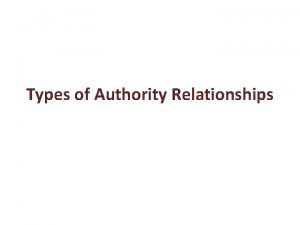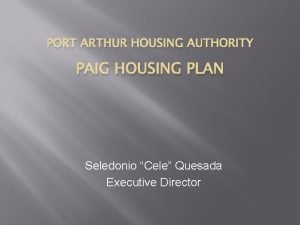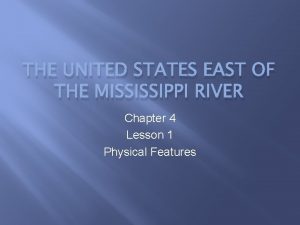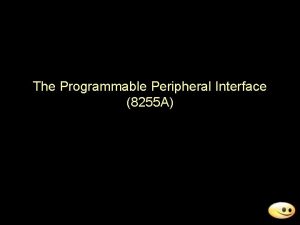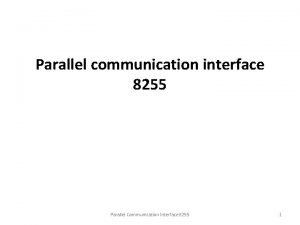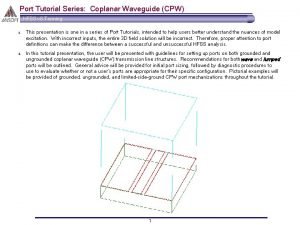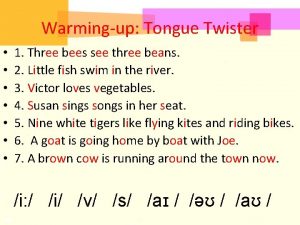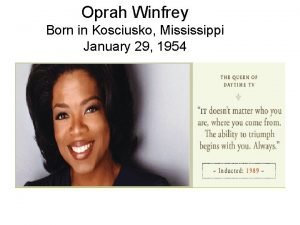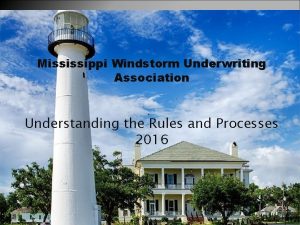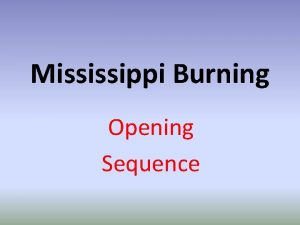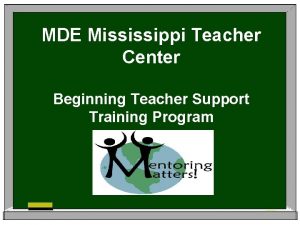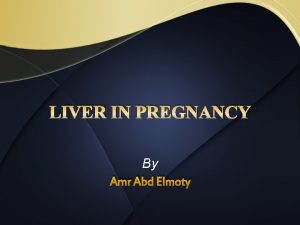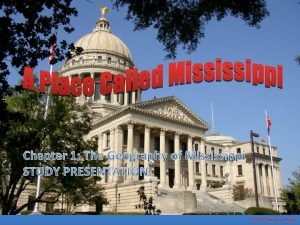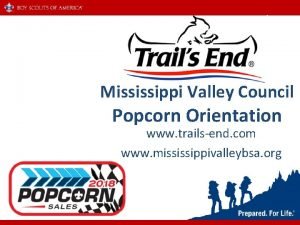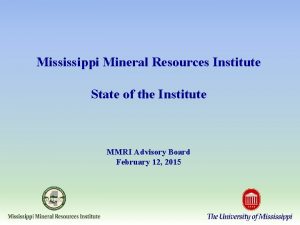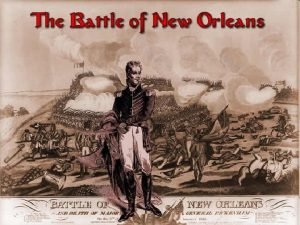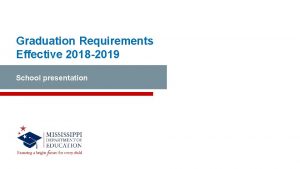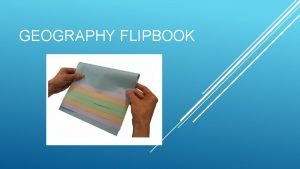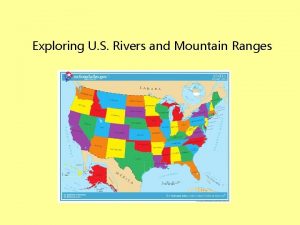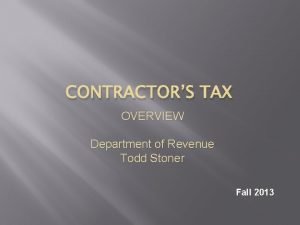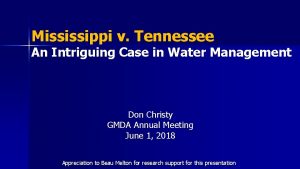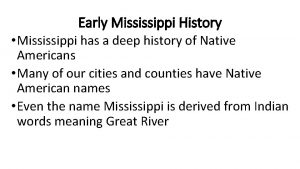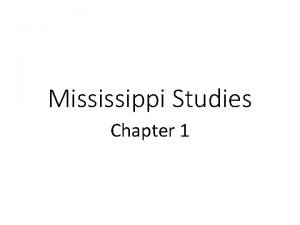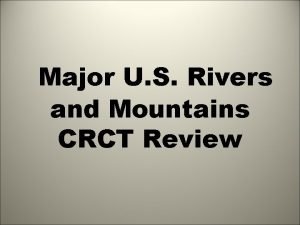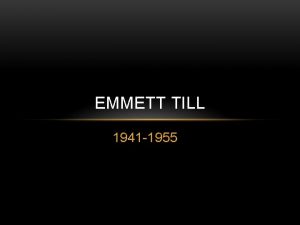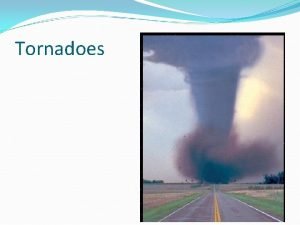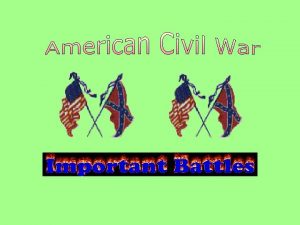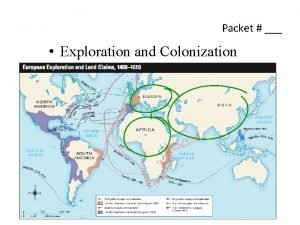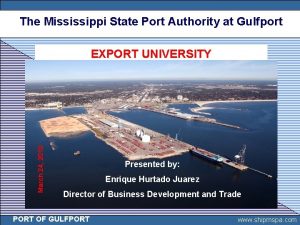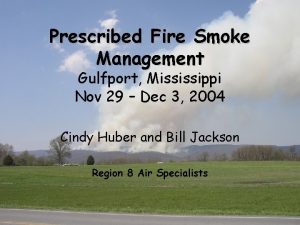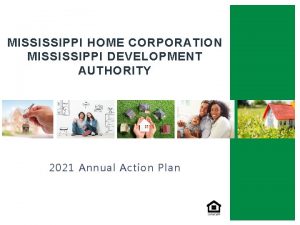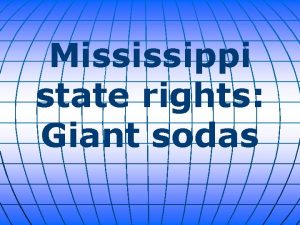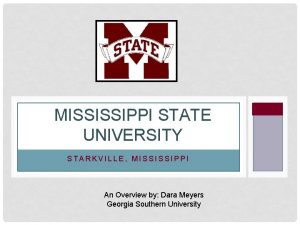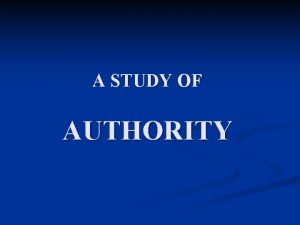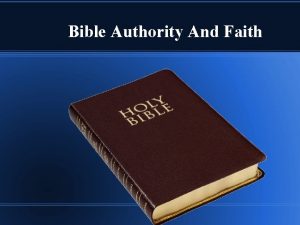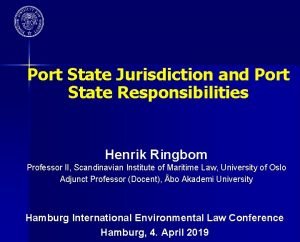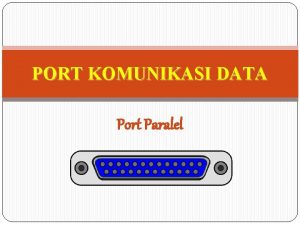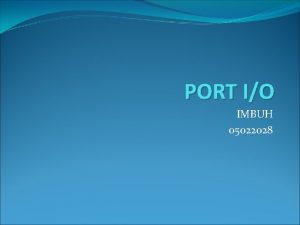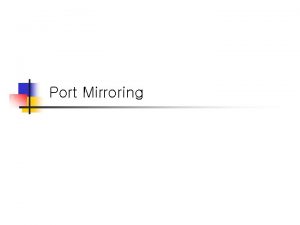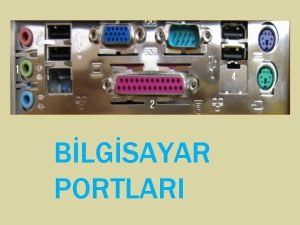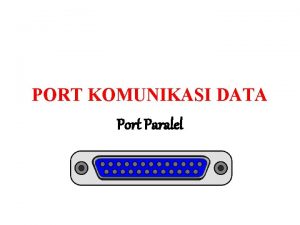Mississippi State Port Authority Port of Gulfport Restoration






















































- Slides: 54

Mississippi State Port Authority Port of Gulfport Restoration Program Section 3/DBE Business Concern Workshop May 15, 2014

The MSPA is an Equal Employment Opportunity Employer and gives preference to Section 3 residents and Section 3 business concerns when new hiring and contracting opportunities arise. More information about Section 3 can be found at www. hud. gov.

Purpose of Today’s Workshop • To focus on providing information and resources for Section 3 and minority business entities who may be interested in the Port of Gulfport Restoration procurement opportunities.

Agenda Introductions, Housekeeping Port of Gulfport Restoration Project Overview Section 3 Overview Davis-Bacon Act Overview Fontello Brown, Cristin Blanchard – Local Section 3 businesses working on the PGRP • Resources for Section 3 and minority businesses • Questions • Networking • • •

Objectives for Today’s Workshop • Provide an overview of the Port of Gulfport Restoration Project. • Help participants develop an understanding of the requirements of Section 3 and the Davis Bacon Act as they apply to Contractors and Sub-Contractors on federal HUD projects. • Have an opportunity to hear from local Section 3 businesses who have successfully won PGRP contracts. • How to certify as a Section 3 Busuness • Make available resource information to assist Section 3 and minority businesses in preparing for a bid submission. • Identify Section 3 businesses to add to the MSPA database.

What is the Port of Gulfport Restoration Program? The Mississippi State Port Authority at Gulfport (MSPA) is in the process of restoring and rebuilding its facilities that were damaged by Hurricane Katrina. This project, called the Port of Gulfport Restoration Program (PGRP), received $570 million in Community Development Block Grant Funds from the U. S. Department of Housing and Urban Development (HUD).

PGRP Objectives The objectives of the PGRP are: – Retain current jobs and create new jobs, generating wages and state and local tax dollars – Enhance future growth opportunities/economic catalyst for Mississippi – Rebuild and restore the Port of Gulfport to its previously permitted footprint – Offer protection from future storm damage

Mississippi State Port Authority at Gulfport – Mississippi’s State Port – Enterprise Agency (self supporting, not state funded) – 295 acres - 6, 000 linear feet of berths – Mobile harbor cranes; roll-on, roll-off; and self unloading capability – Bulk, break-bulk and container cargo

Mississippi State Port Authority at Gulfport - Two million tons of cargo per year - 209, 665 TEUs per year (TEU = twentyfoot equivalent unit) - 3 rd busiest container port on U. S. Gulf of Mexico - 2 nd largest importer of green fruit in U. S. - Tenants include: Chiquita, Crowley, Dole, Du. Pont, Gulf Coast Shipping and the Island View Casino Resort

Conceptual Illustration of Port of Gulfport after Restoration

Aerial View of the Port of Gulfport 5 M tons of fill 1, 000 miles PVD

West Pier Facility Buildings NTP 08/1/14 Duration 410 days Estimated construction cost: $45 -70 M Crowley Chiquita Dole 4 th Terminal +/- 50 Acres

West Pier & Infrastructure, Phase 1 NTP 09/01/14 Duration 575 days Existing rail service remains open to Du. Pont. Estimated construction cost: $55 -70 M

Section 3 Background • HUD funds are one of the largest sources of federal investments in distressed communities. • These funds typically result in new employment, training and contract opportunities.

What is Section 3? HUD’s Section 3 program requires that recipients of certain HUD financial assistance to the greatest extent feasible provide job training, employment, and contract opportunities for low or very-low income residents in connection with projects and activities in their neighborhoods.

What Section 3 is Not • Not race or gender specific • Not an entitlement for eligible individuals and businesses. • Not DBE/WBE/MBE (though they may also qualify as a Section 3 business) • Not optional

Section 3 Covered Projects • The construction or rehabilitation of housing (including reduction of lead-based paint hazards). • Other public construction such as the PGRP.

Applicability • Section 3 requirements apply to the entire project or activity, regardless of whether it is partially or fully funded.

Section 3 - Section 3 applies to the PGRP because of the expenditure of HUD funds on public construction - Section 3 differs from Minority Business Enterprise/ Women Owned Business Enterprise - Section 3 preferences focus on household income and location - Section 3 preferences are race and gender neutral Reference: www. hud. gov/offices/fheo/section 3/FAQ 08. pdf 12 U. S. C. § 1701 and 24 CFR Part 135. 5

PGRP Section 3 Goals – 30% of all employment and training opportunities to be awarded to Section 3 residents – 10% of all construction contracting opportunities to be awarded to Section 3 businesses – 3% of all non-construction contracting opportunities to be awarded to Section 3 businesses

Section 3 Opportunities What Section 3 opportunities are available through the PGRP? - Contracts - Employment - Job training

PGRP Job Creation Jobs are created on two fronts: - Jobs and contracting opportunities created as a direct result of expenditure of Section 3 covered funds - Permanent jobs created by tenants and service providers after the Port is restored

HUD Section 3 - Applied to PGRP - PGRP must make available to low income “Section 3 Residents” jobs and contracting opportunities - Targets Area: Harrison, Hancock and Jackson counties

HUD Section 3 Business Concern – Certification Process Ways to qualify as a Section 3 Business Concern: - Contractor’s firm is 51 percent or more owned by Section 3 residents. - Contractor’s permanent, full-time employees include persons, at least 30 percent of whom are currently Section 3 residents, or within three years of the date of their first employment with the business were Section 3 residents. - Contractor commits to subcontract in excess of 25 percent of the dollar amount of all subcontracts to be awarded by the business under the proposed contract to Section 3 businesses that meet the above two criteria. This must be detailed further in the contractor’s Section 3 Subcontracting Plan.

HUD Section 3 Business Concern – Certification Process Steps of the Section 3 Certification Process: • Complete Section 3 Business Concern Certification form • Submit completed Certification and all necessary supporting documentation. If submitting with bid package, must submit all documentation along with bids • Necessary supporting documentation dependent on how contractor qualifies as Section 3 business

HUD Section 3 Business Concern – Certification Process Refer to your handouts - Complete Section 3 Business Concern Certification form - Submit original to MSPA Compliance Officer for assessment, or submit as part of procurement proposal/bid package

HUD Section 3 Business Concern – Certification Process - Even if you submit documents to the MSPA Director of Compliance and Corporate Responsibility for review, you must still submit all required forms and supporting documentation as part of your procurement proposal/bid package - Each procurement is independent, so you will need to submit all required forms and supporting documentation every time you submit a procurement proposal/bid package

HUD Section 3 Business Concern – Priority Preference Category 1: Section 3 businesses that provide jobs & training for local residents. Category 2: Applicants selected to administer Youthbuild programs Category 3: Other Section 3 business concerns.

Minority Business Enterprise • A minority business enterprise shall be required to present Section 3 certification to receive preference. (HUD) • DBE/WBE/MBE they may also qualify as a Section 3 business.

Section 3 Resident Certification Process • Refer to handouts for 2014 Section 3 Resident Certification form – Individual completes form and gives it to business – Can qualify if “low income” or ”very low income” during the past three years

HUD Section 3 – Hiring Information - Section 3 Residents are considered first in hiring processes (for equally qualified) - All PGRP contractors and subcontractors post new positions with the Mississippi Department of Employment Security Commission’s WIN Job Centers - The PGRP Director of Compliance and Corporate Responsibility and the Workforce Development Coordinator works with residents and Port-related employers to identify training needs; develop job training programs; and coordinate community outreach

Bid Preferences- Section 3, DBE’s • For local business qualification (Corporate or head-office within Mississippi) • For minority-owned, small, woman-owned, veteran owned or otherwise designated DBE based on HUD guidelines. • Respondent is a Section 3 business concern

Section 3 at Work How does Section 3 work? Here’s an example: - XYZ Construction, a qualified, responsible bidder, submitted a $15 million construction proposal (within budget) - XYZ Construction has 50 employees, 25 of whom are Section 3 residents (their annual household income is considered low or very low under HUD guidelines) - XYZ Construction is certified as a Section 3 business - XYZ Construction will receive a preference

HUD Section 3 Business Concern – Requirements for a Section 3 Business Concern: - Record keeping - Reporting - Section 3 plans - Community outreach

HUD Section 3 Business Concern – Requirements Record keeping: - Employee rosters with date of hire - Section 3 resident certification forms - Maintain an interview log through hiring processes - Community outreach efforts to connect with Section 3 residents and businesses - Company documentation Note: It is the Policy of the Port of Gulfport Restoration Program that records with personal information shall remain in a secured, locked location.

HUD Section 3 Business Concern – Requirements Reporting – monthly reports of: - All hiring - All subcontracting opportunities - All outreach activity - If you are unable to hire or contract with Section 3 residents or businesses, then provide a written explanation as to why you could not do so.

Section 3 – Community Outreach As a Section 3 Business Concern, what are ways that I can reach out to the community for new hires and contracts? - The PGRP will offer contractor events and job fairs at which Section 3 Business Concerns can participate - Contact organizations such as community centers, employment agencies, churches, non profits and housing developments - Place ads in local newspapers - Post signs and distribute flyers in the community - See your handouts for comprehensive list of outreach effort ideas

HUD Section 3 Business Concerns - The MSPA is building a database of companies who are likely to qualify and/or have previously qualified as Section 3 Business Concerns - The MSPA Director of Compliance and Corporate Responsibility will distribute these lists to current Port contractors - The MSPA will also distribute these lists to companies that have requested procurement packages/bid solicitations - Additionally, the MSPA will distribute this information to the SMCPC, Small Business Administration and entities subject to HUD Section 3 requirements in this region

HUD Section 3 Business Concern Data needed for MSPA list of companies that might qualify as Section 3 Business Concerns (refer to your handouts): - Company Name - Business Service or Product - Contact Information - Telephone - Mailing and/or Physical Address - Email Address

Why Davis-Bacon(and Related Acts)? • DBRA requires payment of prevailing wages on federally funded or assisted construction projects. The PGRP is such a project. • The Davis-Bacon Act applies to each federal government or District of Columbia contract in excess of $2, 000 for the construction, alteration, or repair (including painting and decorating) of public buildings or public works. • When preparing a bid it is important to be using the current Prevailing Wage rates.

Davis-Bacon Act • Contractors and subcontractors are required to pay covered workers weekly and submit weekly certified payroll records to the contracting agency. (MSPA) • Contractors and subcontractors must pay laborers and mechanics employed directly upon the site of the work at least the locally prevailing wages (including fringe benefits), listed in the Davis-Bacon wage determination in the contract, for the work performed.

Davis Bacon (continued) • The US Department of Labor determines the Prevailing Wage through geographical surveys. • The Davis-Bacon "prevailing wage" is the combination of the basic hourly rate and any fringe benefits listed in a Davis-Bacon wage determination. We have included prevailing wage rates for this project (Facilities, #305) in the bid package. • Apprentices or trainees may be employed at less than the rates listed in the contract wage determination only when they are in an apprenticeship program registered with the Department of Labor or with a state apprenticeship agency recognized by the DOL.

Related Acts The Copeland "Anti-Kickback" Act prohibits contractors from in any way inducing an employee to give up any part of the compensation to which he or she is entitled under his or her contract of employment, and requires contractors to submit a weekly statement of the wages paid to each employee performing DBRA covered work.

Related Acts • Contractors on projects subject to DBRA labor standards may also be subject to additional prevailing wage and overtime pay requirements under State (and local) laws. • Also, overtime work pay requirements under Fair Labor Standards Act may apply.

Consequences of Non-Compliance with Section 3 or Davis Bacon Requirements • Noncompliance with Section 3 and/or Davis Bacon (and Related) Act requirements may result in: – Sanctions – Delayed Pay Requests – Termination of contract for default – Debarment and Suspension from future HUD/federal contracts – Prosecution

Licensing • Your business must hold a current Mississippi State Contractor’s License at the time of your bid submission. • To get licensed in Mississippi contact: – info@msboc. us – or call 601 -354 -6161 or (800)880 -6161.

What is the Pathways to the Port Jobs Program? Pathways to the Port Jobs Program is the PGRP’s centralized process for job placement and workforce training geared toward long-term workforce employment. - NOW: Pathways is being used to connect the local workforce with training and job opportunities generated as a direct result of current expenditures of Section 3 covered funds. - IN THE FUTURE: Pathways will be used to connect the local workforce with training and job opportunities that will be created as the Port finishes various stages or restoration.

What happens if I am successful in winning a contract? If you are a successful contractor or sub-contractor: – We will meet with you for orientation to get you started off the right foot with hiring, recordkeeping, etc. – We will provide on-going technical assistance regarding Section 3, Davis Bacon, etc. – We will be doing periodic monitoring and providing feedback as to how you are meeting your goals and recordkeeping requirements.

Some resources for additional assistance • South Mississippi Procurement Center www. mscpc. com and www. mississippi. org/mptap • Mississippi Minority Business Registry www. mmbr. org • Small Business Administration (SBA) ( www. sba. gov or locally at 1 st floor Hancock Bank Building) • USDOL Wage and Hour Division ( Davis-Bacon, Fair Labor Standards, etc. ) www. dol. gov/whd • Entrepreneur Center www. msenetworks. org • Your Attorney

Questions

Future Outreach Workshops Next Business Outreach workshop: August 14, 2014, Location and Topics TBD Community Outreach meeting to be held in August. Date, Place - TBD

How can I keep informed about the Port and Restoration work? South Mississippi Contract Procurement Center distributes Legal notices/ads in the Sun Herald Portofthe. Future. com Home and Procurement web pages Portofthe. Future. com email/e-blast Facebook Twitter Construction plan rooms

“West Pier Facilities, Project 305” Pre-Bid Meeting Wednesday, May 21, 2014 Westside Community Center 4006 8 th St, Gulfport, MS 39501 Gulfport, MS

HUD Section 3 Business Concern Certification Questions? For more information, or for one-on-one assistance, please contact: Mel Arsenault, Director of Compliance and Corporate Responsibility Officer Mississippi State Port Authority marsenault@shipmspa. com 228 -865 -4300
 Gulfport port authority
Gulfport port authority What is a line authority
What is a line authority Lakeview palms apartments port arthur texas
Lakeview palms apartments port arthur texas Dubrovnik port authority
Dubrovnik port authority Port authority
Port authority Rrc gis viewer
Rrc gis viewer Which states are east of the mississippi river
Which states are east of the mississippi river Mississippi state university library
Mississippi state university library Port a+ port c upper forms group a ports
Port a+ port c upper forms group a ports 8255 block diagram
8255 block diagram Ansys hfss
Ansys hfss Organizational occupational crime?
Organizational occupational crime? Madison line dance
Madison line dance Department of finance and administration
Department of finance and administration Mississippi tongue twister
Mississippi tongue twister Sbac mississippi
Sbac mississippi Oprah mississippi
Oprah mississippi Mississippi windstorm underwriting association
Mississippi windstorm underwriting association Mississippi studies chapter 1
Mississippi studies chapter 1 Backup and disaster recovery mississippi
Backup and disaster recovery mississippi Mississippi burning scene
Mississippi burning scene Mr clark movie
Mr clark movie Mde teacher center
Mde teacher center Mississippi classification of hellp syndrome
Mississippi classification of hellp syndrome Callinectes sapidus
Callinectes sapidus Fluvi america de nord
Fluvi america de nord Tennessee tombigbee
Tennessee tombigbee Symbolism in streetcar named desire
Symbolism in streetcar named desire Trailsend com
Trailsend com Mississippi mineral
Mississippi mineral We fired our guns and the british kept a comin
We fired our guns and the british kept a comin Graduation requirements mississippi
Graduation requirements mississippi Pacific ocean facts
Pacific ocean facts Mountain ranges in the us
Mountain ranges in the us Mississippi 72-010
Mississippi 72-010 What states are west of the mississippi river
What states are west of the mississippi river Unboxing mississippi
Unboxing mississippi Mississippi v. tennessee
Mississippi v. tennessee Mississippi enterprise for technology
Mississippi enterprise for technology Mississippi tornado
Mississippi tornado Joanne ussery 54 from mississippi
Joanne ussery 54 from mississippi Fluviul mississippi
Fluviul mississippi Mississippi department of finance and administration
Mississippi department of finance and administration Mississippi studies chapter 1
Mississippi studies chapter 1 Mississippi studies chapter 1
Mississippi studies chapter 1 Which of the following is the best title for this list?
Which of the following is the best title for this list? Delta mississippi
Delta mississippi Bryants store money mississippi
Bryants store money mississippi Tennessee hellp
Tennessee hellp Fluviul mississippi referat
Fluviul mississippi referat Mississippi river
Mississippi river Mississippi tornado
Mississippi tornado Mississippi river
Mississippi river Mississippi civil war sites map
Mississippi civil war sites map Mississippi river
Mississippi river

